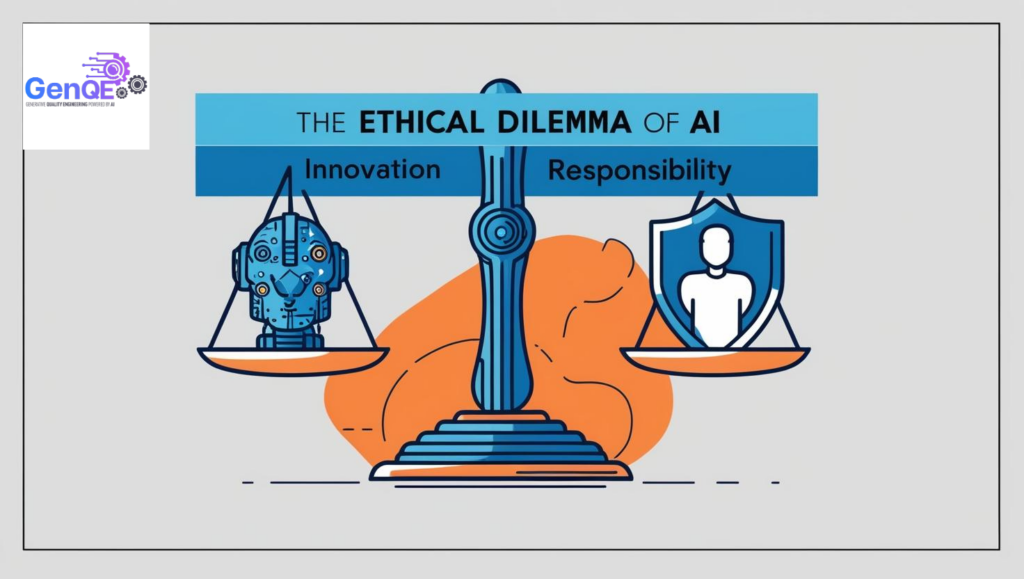
Artificial Intelligence (AI) is rapidly transforming industries, improving efficiency, and redefining the way we work and live. From autonomous vehicles to personalized healthcare and AI-driven decision-making, its impact is undeniable. However, with such advancements come critical ethical concerns that challenge the responsible use of AI.
How do we balance innovation and responsibility while ensuring AI benefits society without causing harm? Let’s explore the key ethical dilemmas of AI and how we can navigate them.
🤖 1️⃣ Bias & Fairness: Can AI Be Truly Unbiased?
AI systems learn from historical data, which can contain inherent biases. If the data used to train AI models is biased, the system itself will perpetuate and even amplify discrimination.
✅ Examples of AI Bias:
- AI hiring tools favoring male candidates due to biased training data.
- Facial recognition systems misidentifying people of certain ethnicities more frequently.
- Predictive policing algorithms disproportionately targeting specific communities.
🔹 The Solution?
Organizations must implement bias detection techniques, use diverse datasets, and adopt explainable AI (XAI) to ensure transparency in decision-making.
🔍 2️⃣ Transparency & Explainability: The “Black Box” Problem
Many AI systems operate as black boxes, making decisions without clear explanations. This lack of transparency can lead to mistrust, especially in high-stakes industries like healthcare and finance.
✅ Example:
- An AI model denies a loan application, but the applicant has no way to understand why or how to challenge the decision.
🔹 The Solution?
Develop explainable AI (XAI) models that provide clear justifications for their decisions, allowing users to trust and verify AI-driven outcomes.
🔐 3️⃣ Privacy Concerns: How Much Data is Too Much?
AI thrives on big data, but excessive data collection raises serious privacy concerns. Many AI applications track, store, and analyze personal information, sometimes without users’ full awareness or consent.
✅ Examples of Privacy Issues:
- AI-powered voice assistants always listening and storing conversations.
- AI-driven targeted advertising profiling users based on browsing history.
- Health tracking devices collecting sensitive medical information.
🔹 The Solution?
Companies must follow data protection regulations like GDPR and CCPA, implement secure encryption, and provide users with more control over their personal data.
🤯 4️⃣ AI & Job Displacement: Automation vs. Employment
AI and automation are increasing productivity, but they are also eliminating jobs in various industries. While AI creates new job opportunities, many workers lack the necessary skills to transition into AI-driven roles.
✅ Industries Impacted by AI Automation:
- Manufacturing & Logistics – AI-powered robots replacing assembly line workers.
- Customer Service – AI chatbots reducing the need for human agents.
- Retail & Finance – AI automating sales predictions, fraud detection, and risk analysis.
🔹 The Solution?
Governments and businesses must invest in AI education, upskilling programs, and reskilling initiatives to help workers adapt to the AI-driven economy.
⚠️ 5️⃣ The Risks of Autonomous AI: Who is Responsible?
As AI systems gain autonomy, questions about accountability and liability become crucial. Who is responsible when an autonomous vehicle causes an accident or an AI system makes a harmful medical diagnosis?
✅ Challenges in AI Accountability:
- Legal liability – Should the AI developer, company, or user be held accountable?
- Ethical decision-making – How should AI prioritize human safety in critical situations?
- Regulatory gaps – Many AI applications lack clear legal frameworks.
🔹 The Solution?
Regulators must establish comprehensive AI governance policies, enforce AI safety standards, and ensure accountability in AI-driven decision-making.
🌍 6️⃣ Ethical AI for a Better Future
Despite these challenges, AI has the potential to improve lives, drive innovation, and solve global problems. The key to responsible AI lies in ethical development, transparency, and accountability.
How Can We Ensure Ethical AI?
✅ Implement Ethical AI Guidelines – Businesses must adopt ethical AI frameworks to ensure fairness and transparency.
✅ Regulate AI Responsibly – Governments must create laws that balance innovation with safety and privacy.
✅ Encourage Public Awareness – Users must be educated about AI risks and their rights in an AI-driven world.
By prioritizing ethics alongside innovation, we can create trustworthy AI systems that benefit everyone while minimizing harm.
🚀 Conclusion: AI Needs Responsible Innovation
AI is a powerful force for progress, but unregulated AI can lead to serious ethical concerns. Striking a balance between technological advancement and ethical responsibility is essential for ensuring that AI remains a tool for good.
💡 What do you think? How can we make AI more ethical while still encouraging innovation? Let’s discuss in the comments! 💬